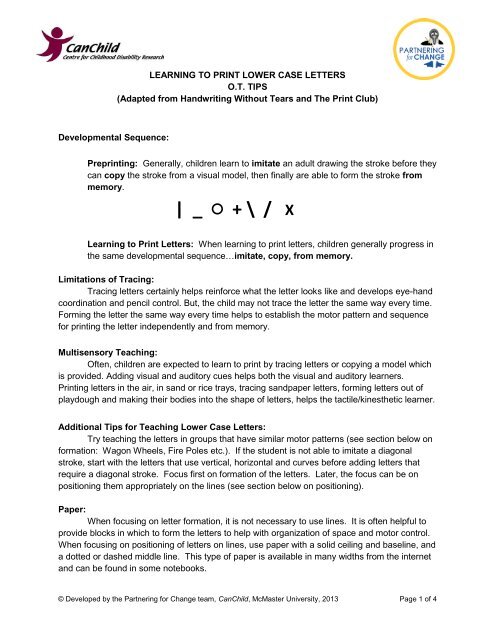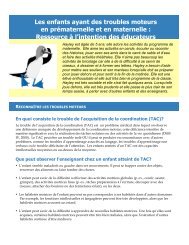PrePrinting and Fine Motor Skills â Lunch & Learn Goals ... - CanChild
PrePrinting and Fine Motor Skills â Lunch & Learn Goals ... - CanChild
PrePrinting and Fine Motor Skills â Lunch & Learn Goals ... - CanChild
You also want an ePaper? Increase the reach of your titles
YUMPU automatically turns print PDFs into web optimized ePapers that Google loves.
LEARNING TO PRINT LOWER CASE LETTERSO.T. TIPS(Adapted from H<strong>and</strong>writing Without Tears <strong>and</strong> The Print Club)Developmental Sequence:Preprinting: Generally, children learn to imitate an adult drawing the stroke before theycan copy the stroke from a visual model, then finally are able to form the stroke frommemory.| _ ○ + \ / X<strong>Learn</strong>ing to Print Letters: When learning to print letters, children generally progress inthe same developmental sequence…imitate, copy, from memory.Limitations of Tracing:Tracing letters certainly helps reinforce what the letter looks like <strong>and</strong> develops eye-h<strong>and</strong>coordination <strong>and</strong> pencil control. But, the child may not trace the letter the same way every time.Forming the letter the same way every time helps to establish the motor pattern <strong>and</strong> sequencefor printing the letter independently <strong>and</strong> from memory.Multisensory Teaching:Often, children are expected to learn to print by tracing letters or copying a model whichis provided. Adding visual <strong>and</strong> auditory cues helps both the visual <strong>and</strong> auditory learners.Printing letters in the air, in s<strong>and</strong> or rice trays, tracing s<strong>and</strong>paper letters, forming letters out ofplaydough <strong>and</strong> making their bodies into the shape of letters, helps the tactile/kinesthetic learner.Additional Tips for Teaching Lower Case Letters:Try teaching the letters in groups that have similar motor patterns (see section below onformation: Wagon Wheels, Fire Poles etc.). If the student is not able to imitate a diagonalstroke, start with the letters that use vertical, horizontal <strong>and</strong> curves before adding letters thatrequire a diagonal stroke. Focus first on formation of the letters. Later, the focus can be onpositioning them appropriately on the lines (see section below on positioning).Paper:When focusing on letter formation, it is not necessary to use lines. It is often helpful toprovide blocks in which to form the letters to help with organization of space <strong>and</strong> motor control.When focusing on positioning of letters on lines, use paper with a solid ceiling <strong>and</strong> baseline, <strong>and</strong>a dotted or dashed middle line. This type of paper is available in many widths from the internet<strong>and</strong> can be found in some notebooks.© Developed by the Partnering for Change team, <strong>CanChild</strong>, McMaster University, 2013 Page 1 of 4







